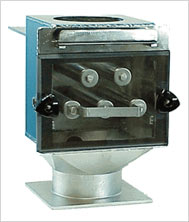- Overband Magnetic Separators
- Suspended Plate Magnets
- Magnetic Drum Separators
- Plate Magnets
- Drawer Magnets
- Roller Type Magnetic Separators
- Gravity Feed Magnets
- Grinder Plate Magnets
- Hump Magnet
- Lifting Magnets
- Liquid Line Magnets
- Magnetic Coolant Separators
- Center Flow Magnets
- Magnetic Liquid Traps
- Cartridge Magnetss
- Cross Belt Separators
- Pneumatic In Line Magnets
- Grate Magnets
- Drum Magnets
- Tube Magnets
- Wet Drum Separators
Home » Magnetic
Separators » Drawer Magnets
Drawer Magnets
| Working | Types | Features |
| Applications | Latest Innovation |
Drawer magnets consists of a row, or most commonly, rows of round magnetic tubes that are assembled into drawers. The tubes of the drawer magnet separators are aligned on lternating centers from the row directly above or below it. For protecting injection molding machines, molds and dies, drawer magnet separators are very essential engineering products. The powerful magnets at the neck of the molding machine stops the flow of the tramp material directly into the machine parts. Drawer magnets are available in different styles to suit specific application needs.
The product cascade in a zig-zag pattern from row to row over the magnetic tubes as soon as it flows into the top of the housing. This methodology helps in the trap of maximum tramp metal because the product comes in direct and repeated contact with a magnet. Ferrous metal while moving through the magnetic field is held to the tubes and separated from the product. The trapped metals are later cleaned from the tubes to prevent buildup and subsequent wash-off back into the product flow.
 Based on the sizes, configurations and the work capacities, drawer magnet separators are classified as:
Based on the sizes, configurations and the work capacities, drawer magnet separators are classified as:
- Heavy Duty
Heavy duty drawer are useful for optimum magnetic separation in tough processing conditions like ambient temperature and humidity, bridging, abrasion, corrosion or galling. There are special coating on the drawer's tubes that prevents sticking problems associated with certain products and processing conditions. Due to this the cleaning operations becomes even more easier. The cleaning can be accomplished both manually and automatically.
- Large Tube
In larger drawer magnets rare earth magnetic tubes are incorporated optimum ferrous metal separation on difficult flowing products such as flour, powdered sugar and other products with a tendency to bridge. The placement of larger tubes below steep angled diverters that prevent product from bridging or building up on the tubes. And, since the spacing between the tubes is larger it allows the product to flow freely through the housing. - Manual Clean
For low levels of tramp metal contamination manual clean drawer magnets are ideal. The magnetic tubes are located on the alternating centers of the tubes. The trapped materials can be removed with the help of shop rag or gloved hand. - Self-Cleaning
In difficult locations self-cleaning magnetic drawer is considered as suitable. Through the toggle switch the operator can easily clean the assembly from a remote location.
Following are the features of the drawer magnets:
- The drawer magnets can be fitted simply in existing pipe line or outlet of various equipments like pulverizer, blenders etc.
- Generally each unit comprises of permanent magnetic grids mounted one above the other.
- For special applications there are system with multiple grids.
- The grids are easily removable for cleaning.
- Normally the ferrite or rare earth and NdFeB magnets are used in the drawer magnets.
- Certain types of drawer magnets handle a wide range of separation tasks in gravity conveying systems
The drawer magnets find their applications in following areas:
- Mining industries
- Pharmaceuticals industries
- Food processing industries
- Industries dealing with powdery substance
- Cement, gypsum and other types of small scale industries.
The latest design of drawer magnet will use high strength and high temperature neodymium magnets that can capture and hold even minutest possible ferrous metal particles which cannot be traced from the naked eyes. This precise separation not only reduces the time of separation but also reduce the screw wear and fewer plugged hot runner nozzles. Built with a rugged stainless steel the drawer magnet separators can be mounted at the injector throat. The gasket of the drawer is designed to far outlast sponge rubber. It is cut from Ethylene Propylene Diene (EPDM) to provide extended durability and to resist heat aging and
